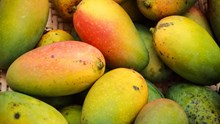
Common name:
Guava is commonly called “Amrud” in the official language of India, Hindi.
Scientific name:
Psidium guajava
Features:
Guava is a hardy, long-lived tree and a prolific bearer. It has high commercial significance. Guava cultivation is very profitable and requires not much care.
Producing States:
Guava farming is done all over India. Chief states producing guava are Uttar Pradesh, Madhya Pradesh, Bihar, Andhra Pradesh, Haryana, Punjab Maharashtra, West Bengal, Chhattisgarh, Gujarat and Karnataka.
Uttar Pradesh is the most important state for guava production. Allahabad is famous for producing the best quality guava in India and the world.
As per a report by National Horticulture Board (NHB), the area under guava cultivation in Uttar Pradesh alone accounted for a production of 983.59 ('000 MT) with a 21.78% share.
India exports guava fruits to several countries including Bangladesh, the Netherlands, the UAE, the UK, Nepal, Iran, Russia, Saudi Arabia, Oman and Qatar.
The export of guavas from India sees a growth of 260% since 2013. Exports grow from USD 0.58 Million in April-January 2013-14 to USD 2.09 Million in April 2021-22.
Guava Varieties:
Some of the popular varieties include:
-
Lucknow 49 (the most popular variety, also called ‘Sardar’ guava)
-
Allahabad Safeda
-
Apple color
-
Pear Shaped
-
Behat Coconut
-
Safeda Jam (hybrid: Allahabad Safeda X Kohir)
-
Kohir Safeda (hybrid: Kohir X Allahabad Safeda)
-
Arka Mridula (soft-seeded)
-
Arka Amulya (soft-seeded)
-
Banarasi
-
Chittidar
-
Baruipur Local
Hero Organics has released a high-yielding and profitable variety of guava that is gaining the attention of farmers.
Guavas come in a variety of exotic types that are grown all over the world. Some of them are mentioned below:
-
Mexican Cream: This white-fleshed variety has a creamier texture, making it a favorite dessert choice.
-
Tropical White: White-fleshed variety packed with sweetness.
-
Red Malaysian: This variety features red flesh, gorgeous pink blooms, and red leaves, and is a gardener's favorite.
-
Pineapple Guava: Grown usually in Colombia, Brazil, and Argentina, this white-fleshed variety is drought resistant.
-
Thai Maroon: A beautiful variety just like Red Malaysian, it features reddish pink flesh and red leaves.
-
Ruby X: Thick-skinned variety, resistant to fruit flies.
-
Giant Vietnamese: This white-fleshed variety is a great choice for making juice.
Climate Required:
Guava farming is possible in both subtropical and tropical climes. It can reach a maximum height of 5000 feet (1500 metres) above sea level.
Guava blossoms best in the months of June to September, when the annual rainfall is less than 1000 mm.
Because young plants are more susceptible to cold and dry environments, they require more care.
Soil Required:
Guava is a hardy plant that thrives in a variety of soil conditions. It thrives on heavy soils that are well-drained. It is, nevertheless, susceptible to waterlogging. Because guava is surface-rooted, the best soil is well-drained, deep friable soil with rich topsoil
The soil should have a fertile surface. Its pH ranges from 4.5 to 8.2. Guavas cannot be grown on alkaline or saline soils.
Mode of Propagation:
-
Seed
-
Grafting
-
Budding
-
Cutting
-
Air layering
-
Stooling
For commercial guava growing, air layering has proven to be the most successful method of propagation.
Stooling, or mound piling on nursery beds, is the most cost-effective method of rapid multiplication.
Soil preparation:
-
Deep ploughing, cross ploughing, harrowing, and soil leveling are the first steps.
-
Before the monsoon, dig holes measuring 0.6 m x 0.6 m x 0.6 m.
-
Allow 15-20 days for them to breathe.
-
Then fill them with soil using 500 grams of superphosphate and 20 kilograms of organic manure.
-
In the event of bad soil, larger pits of 1 m x 1 m x 1 m must be dug. More organic manure should also be added.
-
Start planting as soon as the monsoon arrives.
Spacing:
Standard spacing is 6 m x 6 m. This accommodates 112 plants per acre.
Flowering and fruiting period:
The main flowering seasons are:
|
Area |
Seasons |
|
Northern India |
April-May and August-September |
|
Eastern India |
April-May and September-October |
|
Southern India |
April-May and August-September |
|
Western India |
February-March, June-July, and October-November |
There are names for different flowering seasons in guava farming. Each season features different qualities in fruits.
|
Flowering pattern |
Flowering period |
Fruit ripening period |
Preference |
|
Ambe Bahar |
February-March (spring) |
July-September (monsoon) |
Not preferred much due to poor quality fruits |
|
Mrig Bahar |
June-July (monsoon) |
November-January (winter) |
Most preferred due to excellent quality fruits |
|
Hasth Bahar |
October (autumn) |
February-April (spring) |
Usually practiced in South and West India. Fetches good prices. |
In guava production, fruit drop can be a source of concern. Due to a variety of environmental and physiological conditions, the decline can be as high as 45-65 percent.
Fruit drop reduction using GA spray is successful.
Irrigation Requirement:
The guava tree does not require much watering. Guava plants in their early stages require 8-10 irrigations per year.
Dry locations and light soils may require hand watering during the summer. Between May and July, full-grown and fruit-bearing trees require weekly watering.
Fruit drop is reduced and fruit size is increased with winter watering. The guava crop benefits greatly from drip irrigation. It saves up to 60% of water and increases the number and size of fruits significantly.
To keep moisture in the soil following pre-monsoon showers, make a saucer-shaped, half-moon, or V-shaped basins.
Fertilizers:
Inorganic fertilizers and organic manure are quite beneficial for guava cultivation. Every year, give your plants 100 grams of nitrogen, 40 grams of phosphorus, and 40 grams of potassium. In the sixth year, you should be able to maintain your current level of stability. In August and January, divide them into two equal portions.
Spray the trees with 0.34 kg slaked lime and 0.45 kg ZnSO4 (Zinc Sulfate) dissolved in 16 gallons (72.74 l) of water if the trees are deficient in zinc. Determine how many sprays to use based on the degree of the deficit.
Apply pre-flowering sprays of 0.3 percent ZnSO4 and 0.4 percent Boric Acid to your guava crop to boost fruit size and yield.
Weed management:
Manual weeding is better. Mulching twice a year discourages weeds and conserves moisture. Spray of Gramoxone is effective in weed management.
Plow soil twice a year (once in October, next in January) for effective management of guava orchards.
Intercropping:
Intercropping can be done with a combo of vegetables, legumes, and plantation crops. Cabbage, cucumber, cauliflower, pineapple, papaya, beans, cowpea, and peas are good choices.
Training & Pruning:
Fruit quality and yield are improved by training. The main goal of training is to provide a productive foundation for the tree, with robust branches capable of bearing a high-yielding crop.
Shoots that are 30 cm or less from the ground are chopped off. Allow the centre to be clear. Allow for the growth of four scaffold branches. Maintain a wide enough angle between the stem and the branches to allow sufficient sunshine to reach the centre.
Light pruning is done once a year to keep the tree's framework in good shape and encourage the emergence of new branches.
https://www.youtube.com/watch?v=kM1uES6xcWo
Pest & Diseases:
Pests:
-
Scale insect: In Punjab, Uttar Pradesh, Bihar, and Maharashtra, there is a serious problem. These flat, green insects that seem like scales cling to plants, stems, and fruits. Spray a mixture of fish oil rosin soap, methyl demeton, and dimetholate in a crude oil emulsion or water.
-
Guava fruit fly: A dangerous pest that induces fruit dropping. Pluck and burn the infested fruits. Spray 0.5 ml phosphamidon and 2 ml malathion per liter of water.
-
Mealybug: These tiny oval-shaped insects sucking sap from young plants have a white waxy surface. Underneath the leaves, in bunches. They have a significant impact on yield. Dimethoate, methyl parathion, or monocroptophos can be sprayed. Thimet, malation, or aldrin can be used to treat soil. Block the upward movement of nymphs on plants by covering the plant base with polythene fabric.
Diseases:
-
Guava wilt: A serious fungal disease that causes yellowing of leaves, followed by drying, wilting, and dying. More serious in alkaline soils and during monsoon. Remove dry and wilted parts. Drench with Brasicol at trunk base. Spray Bavistin at earliest infection stage. Injections of 8-Quinolonol Sulfate is effective.
-
Anthracnose: Causes spots on leaves and fruits. Remove affected parts. Spray Dithane, Oxychloride, or Difolatan. To control this disease in post-harvest fruits, dip them in Aureofungin and Thiabendazole solutions.
-
Fruit canker: It decreases market value of fruits, as the disease disfigures them. Dip harvested fruits in Ocimum sanctum leaf extract. Or wash them with 1200 ppm Aureofungin. Spray 0.2% Dithane Z-78, 0.3% Difolatan, and 1% Bordeaux mixture.
-
Stem canker: Infected stems crack and produce lesions. Stem tissues collapse and the twigs wilt.
-
Cercospora leaf spot: The affected leaves develop water-soaked brown patches. Spray 0.3% Copper Oxychloride or lime sulphur at 1:30 ratio.
Disorders:
Bronzing is a nutritional disorder that happens due to deficiencies of phosphorus, potassium, and zinc. It occurs because of poor soils or poor cultivation and management practices. Apply NPK, Zinc, and Boron in recommended doses.
Harvesting:
Guava fruits should be picked as soon as they mature. The fruit is ready for harvest when its dark green color changes to light and shows yellowish green patches.
Hand picking is recommended.
Seedling trees take 4-5 years to reach the bearing stage, while layered, budded, and grafted trees take 2-3 years to bear.
Storage:
Guava fruits are highly perishable. Their shelf life is an average of 2-3 days in ambient conditions. So, you must market them as soon as possible after harvest.
Pack the fruits in corrugated fiberboard boxes featuring sufficient perforation. In cold storage, fruits stay fresh for 3-5 weeks at 8-10ocelsius and 85-90% relative humidity.
Yield:
-
Grafted trees can yield up to 350 kg per tree, whereas seedling plants can yield up to 90-150 kg or 10-15t/ha.
-
In an ideal condition, a 3-year-old Lucknow 49 tree may produce somewhere between 55 and 60 kilograms.
-
Yield varies by variety, cultivation tactics, location, and orchard management.
-
Guava leaves can be used to treat toothaches, mouth ulcers, and inflamed gums at home.
-
Guava contains pyridoxine (Vitamin B6) and niacin (Vitamin B9), which aid to increase mental capacity. It increases flow of blood in brain and improves cognitive performance.
-
Guava is an anti-aging fruit. It improves the appearance of the skin. It has astringent properties.
-
Guava is a stress buster thanks to its magnesium content. So, if you have had a hard day at the office, eat a guava and relax! (You can also read about 10 fruits that contain more vitamin C)
Contact us to sell guava
If you grow Lucknow-49 and Allahabad Safeda varieties of guava or know anyone in your contact who does and are looking to sell them, then contact us at - 9891614614 and 9818875912.



















